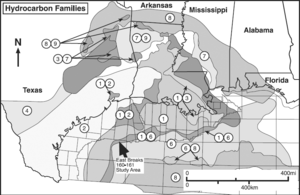Difference between revisions of "Maps of hydrocarbon types: Gulf of Mexico example"
(Initial import) |
(No difference)
|
Revision as of 18:48, 30 January 2014
| Exploring for Oil and Gas Traps | |

| |
| Series | Treatise in Petroleum Geology |
|---|---|
| Part | Critical elements of the petroleum system |
| Chapter | Sedimentary basin analysis |
| Author | John M. Armentrout |
| Link | Web page |
| Store | AAPG Store |
Discussion
Hydrocarbon types reflect the composition of the kerogens from which they were generated. Kerogens are the insoluble organic matter in sedimentary rocks. Maps of hydrocarbon types estimate the number and distribution of mature generating [[source rocks]]. The following map of hydrocarbon types is based on analyses of more than 2000 oil, 600 gas, and 1200 seep samples correlated to specific source rocks. Nine oil-source-rock families have been identified (labeled 1-9; see table on following page), each having a specific geographic distribution related to mature source-rock location and migration paths. We will focus on the High Island-East Breaks area, where families 1 and 6 overlap (bold arrow).
Source table
The table below, modified from Gross et al.[1] lists source-rock ages, oil types, and map numbers for Figure 4-5.
| Source-rock age | Oil type | Map # |
|---|---|---|
| Lower Tertiary (centered on Eocene, ~50-40 Ma) | Tertiary marine [t 1] <break> </break> Tertiary intermediate [t 1] Tertiary terrestrial |
|
| Upper Cretaceous (centered on Turonian, ~85-95 Ma) | Marine; low sulfur; no Tertiary influence <break> </break> Calcareous; moderate sulfur; no Tertiary influence [t 2] |
|
| Lower Cretaceous (centered on Aptian, ~115-105 Ma) | Carbonate; elevated salinity; Lower Cretaceous <break> </break> Calcareous; moderate sulfur; Lower Cretaceous [t 2] |
|
| Uppermost Jurassic (centered on Tithonian, ~140-130 Ma) | Marine; high sulfur; Jurassic [t 3] <break> </break> Marine; moderately high sulfur; Jurassic [t 3] <break> </break> Marine; moderate sulfur; Jurassic [t 3] <break> </break> Calcareous; Upper Jurassic or Lower Cretaceous? |
|
| Upper Jurassic (Oxfordian, ~ 152-145 Ma) | Carbonate; elevated salinity; Jurassic [t 4] |
|
| Triassic (Eagle Mills, > 210 Ma) | Triassic; lacustrine |

Summary
By overlaying maps of total overburden thickness above major source-rock intervals, thermally mature source-rock distribution, hydrocarbon occurrences, and major structural features, the regional elements of the petroleum system(s) begin to emerge.
See also
- Defining the basin framework
- How to define the framework of a basin
- Example: defining a basin outline
- Example: mapping sediment thickness and field location
References
External links
Cite error: <ref> tags exist for a group named "t", but no corresponding <references group="t"/> tag was found